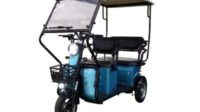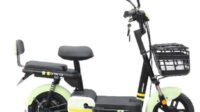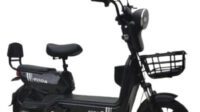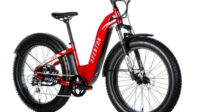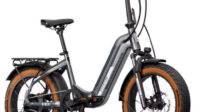
Hello, everyone! This is Edwin reporting from Gosondors.com. Today, I will be explaining the difference between pedal assist and throttle on e-bikes. It may not be rocket science, but understanding these features is important.
Throttle
Let’s start with the throttle. When I first started exploring e-bikes, I was unsure about the dissimilarity between the throttle and pedal assist.
If you’re in the same boat, don’t worry—I was once in your shoes. However, through extensive experience and learning, I can now shed light on this simple yet significant topic.
The throttle is a concept that most people are familiar with, as it functions similarly to a gas pedal in a vehicle. Instead of a foot pedal, e-bikes typically have a small thumb lever that you can push.
Similar to how pressing the gas pedal accelerates a car, pushing the throttle makes the e-bike go faster.
It’s like the throttle on a motorcycle, where twisting it increases your speed.
Pedal Assist
Now, let’s talk about pedal assist. I must admit, I had trouble comprehending pedal assist until I actually rode an e-bike. However, I’ll do my best to explain it to you so you can grasp the concept.
With pedal assist, you can adjust the level of assistance you receive while pedaling. On this particular bike, you can choose from five different levels, including zero, which means no assistance at all.
The five levels provide increasing amounts of power assistance.
Without any assistance, it would be akin to riding a regular bicycle without any external help. However, when you engage pedal assist and start pedaling, the e-bike’s system senses your pedal movement and provides assistance accordingly based on the level you’ve selected.
For instance, if you choose level two, you’ll receive around 40 percent power assistance, utilizing 40 percent of the battery’s capacity to propel you forward at a faster pace.
Pedal assist ensures a steady stream of power while pedaling. This feature is particularly beneficial for recreational bikes.
In mountain biking and some road biking scenarios, it might not be the ideal setting.
However, for casual riding, having a pedal assist system that operates based on cadence (pedal movement) is perfect.
As long as you keep pedaling, the assistance will be there. If you start coasting, such as going downhill, the assistance will cease, and you’ll glide just like on a regular bike.
Pedal assist offers a fantastic experience, akin to having someone gently push you along at a consistent pace.
With this feature, you don’t have to worry about using the throttle or adjusting your speed manually. The e-bike takes care of it for you.
If the assistance feels insufficient, you can increase it to levels three, four, or five.
Conversely, if you desire a more challenging workout, you can reduce it to levels two, one, or even turn it off completely, opting for a traditional leg workout.
Throttle and Pedal Assist
Now, let’s explore the rationale behind having both the throttle and pedal assist on a bike. Imagine this scenario: you’re cruising along on a flat surface with your e-bike set to a comfortable pedal assist level of two or three.
Suddenly, you encounter a challenging hill. Instead of having to adjust your pedal assist to a higher level, you can simply engage the throttle.
The throttle will provide that extra boost you need to conquer the incline. Similarly, if you find yourself desiring a burst of speed for any reason, activating the throttle will grant you an additional boost beyond the pedal assist.
The Flexibility is the Key Advantage
This flexibility is the key advantage of having both systems available.
However, it’s worth noting a feature that some bikes possess but ours do not. On certain models, the throttle is limited to the level of assist you have selected.
For instance, if you are in pedal assist level two, the throttle won’t provide more power than what level two offers. Personally, I find this limitation inconvenient.
I prefer having the ability to use the throttle to access greater power than what my pedal assist provides, particularly when tackling hills, facing headwinds, or navigating through traffic lights.
Fortunately, our bikes offer unrestricted throttle power, allowing you to utilize the full range from zero to one hundred percent, regardless of the pedal assist level you’ve chosen (one to five).
Hopefully, this clarifies the fundamental purposes of both the throttle and pedal assist. Initially, like many others, I questioned the need for pedal assist when a throttle seemed sufficient.
However, the beauty of pedal assist lies in its seamless operation. With pedal assist, you can enjoy the sensation of a steady tailwind propelling you forward without constantly adjusting the throttle.
It delivers a smooth and consistent boost, which is particularly suitable for recreational riding.
It’s important to mention that there is another type of pedal assist known as torque sensing, primarily used for technical mountain biking.
Enthusiasts in that domain prefer torque sensing, but for recreational riders like us, cadence sensing, like the one incorporated in our bikes, provides the desired experience of a gentle and consistent push.
I sincerely hope that this overview has shed some light on the purpose and benefits of both throttle and pedal assist systems.
Whether you opt for the convenience of the throttle, the pleasant assistance of pedal assist, or a combination of both, may you find your ride to be even more enjoyable and effortless.
Thank you for your attention and happy riding!
- 12 Kata-Kata Bijak Pentingnya Komunikasi yang Baik, Tiket Menuju Sukses – November 15, 2023
- 35 Quotes tentang Public Speaking yang Menginspirasi – November 15, 2023
- Review Sepeda Listrik Uwinfly Dragonfly 7 (DF7) – November 14, 2023


